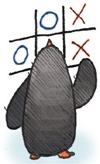Chapter 3. What Games Are

Which brings us, finally, to games.
If you review those definitions of “game” I presented earlier, you’ll see that they have some elements in common. They all present games as if they exist within a world of their own. They describe games as a simulation, a formal system, or as Huizinga put it, a “magic circle” that is disconnected from reality. They all talk about how choices or rules are important, as well as conflict. Finally, a lot of them define games as objects that aren’t real, things for pretending with.
But games are very real to me. Games might seem abstracted from reality because they are iconic depictions of patterns in the world. They have more in common with how our brain visualizes things than they do with how reality is actually formed. Since our perception of reality is basically abstraction anyway,* I call it a wash.
The pattern depicted may or may not exist in reality. Nobody is claiming that tic-tac-toe is a decent mimicry of warfare, for example. But the rules we perceive—what I’ll call the pattern—get processed exactly the same way we process very real things like “fire burns” and “how cars move forward.”
The world is full of systems that we can choose to approach as games, and by approaching them that way, we make them into games. Games are puzzles to solve, just like everything else we encounter in life. They are on the same order as learning ...
Get Theory of Fun for Game Design, 2nd Edition now with the O’Reilly learning platform.
O’Reilly members experience books, live events, courses curated by job role, and more from O’Reilly and nearly 200 top publishers.

